Are you considering installing a wooden fence but not sure about the cost and types available? In this comprehensive article, we will explore the types of wooden fences, factors that affect the cost of installation, and the average cost of installing a wooden fence.
We will also discuss how you can save money on installing a wooden fence. Whether you are looking for a picket fence, privacy fence, or split rail fence, we've got you covered with all the information you need to make an informed decision.

A wooden fence is a traditional addition to any property, serving as a boundary marker, privacy enhancer, and decorative feature that comes in various styles and options. It is known for its durability and requires regular maintenance.
Fences play a pivotal role in demarcating the property, creating a sense of security, and adding curb appeal. There are various options available, such as picket fences, split rail fences, and lattice fences, offering versatile choices to suit different aesthetic preferences.
The right design can complement the architectural style of the house and landscape. Durability is a key factor, with cedar, redwood, and pressure-treated wood being popular choices due to their resistance to rot and decay. Regular staining or sealing is crucial for maintenance to protect the wood from weather elements.
Take a look: How To Install Glass Pool Fence
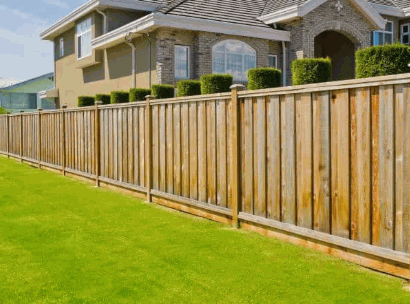
Wooden fences come in various types, including picket fences, privacy fences, split rail fences, and shadowbox fences, each offering distinct features and visual appeal.
The picket fence is known for its charming and classic look with evenly spaced vertical boards, creating an open and welcoming feel.
On the other hand, privacy fences provide a secluded atmosphere due to their closely spaced vertical boards, ensuring a sense of seclusion and security.
Split rail fences are renowned for their rustic appearance, consisting of horizontal rails and widely spaced vertical posts.
Conversely, shadowbox fences offer an aesthetically pleasing appearance from both sides, with alternating boards to provide privacy without a closed-off feel.
A paling fence is a classic wooden fence option known for its decorative appeal and its ability to enhance the charm of the property.
Wooden fencing is a popular choice due to its timeless aesthetic and versatility in complementing different architectural styles. Its evenly spaced vertical boards and stylish paling top can add an elegant touch to any home. Homeowners can further customize their fences with options like pointed, round, or flat palings to reflect their personal style. The natural warmth of wood can also be enhanced with a variety of stains or paints, providing endless design possibilities.
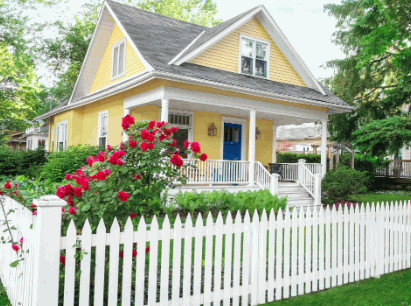
A privacy fence, as the name suggests, is a wooden fence designed to create a secluded boundary. It is available in various styles and options to suit different preferences.
Privacy fences serve a variety of purposes, such as providing a safe and private outdoor space for families and enhancing curb appeal. Common styles include board-on-board, stockade, and lattice fences, each with unique aesthetic and functional benefits.
Homeowners have the option to choose from different wood types, decorative toppers, and stain or paint choices to customize their privacy fence and complement their home's architecture and landscaping.
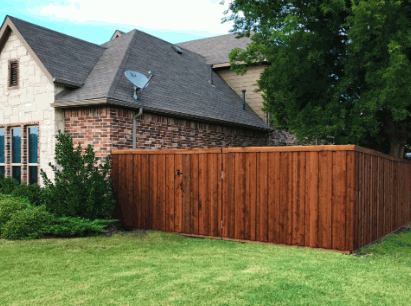
A post and rail fence is a rustic wooden fence option commonly used to mark boundaries and add a touch of natural charm to a property. It is known for its cost-effectiveness.
A post and rail fence stands out from other types of fences due to its cost-effectiveness and simple construction using minimal materials. Its rough-hewn and unrefined appearance makes it a popular choice for those seeking a traditional and organic aesthetic. The open design of this fence allows for clear property line delineation while still creating a welcoming atmosphere. As the wood weathers naturally, it adds to the fence's rustic charm, bringing timeless beauty to any landscape.
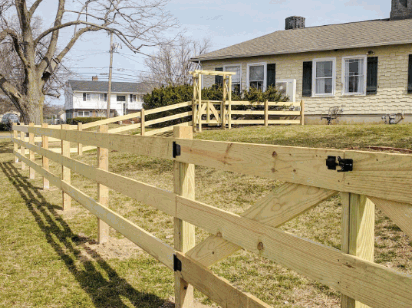
A shadowbox fence is a versatile wooden fence designed to offer both decorative appeal and privacy. It features an innovative design that allows air and light to pass through while maintaining privacy.
This type of fence is constructed with overlapping pickets on two opposite sides, creating a seamless, visually pleasing appearance from both sides. The alternating panels provide glimpses of the surroundings, adding an aesthetic element to the fence.
The innovative design also offers excellent wind resistance and durability. Shadows cast by the overlapping pickets create a captivating visual effect, enhancing the overall appeal of the fencing. This dual functionality makes shadowbox fences a popular choice for residential properties seeking an elegant, yet practical fencing solution.
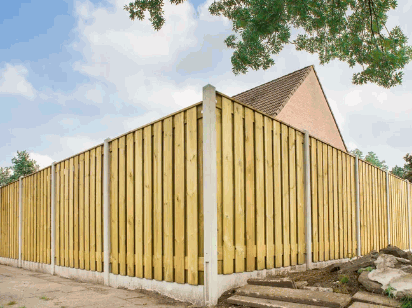
Several factors influence the cost of installing a wooden fence, including the type of wood used, the length and height of the fence, design and style choices, labor costs, and considerations related to permits, regulations, and property planning.
The type of wood used plays a significant role in the overall cost. Options range from affordable pressure-treated pine to more expensive cedar or redwood.
The dimensions of the fence, including both length and height, impact material costs and installation expenses. Design choices, such as decorative elements or customizations, can also drive up the price.
Labor costs vary based on the complexity of the installation and the expertise required. Navigating permits and property regulations can add expenses, as compliance is essential for a successful project.
The type of wood used for a wooden fence significantly influences the cost, with different wood species offering varying levels of quality and durability, allowing for cost comparisons and quality considerations.
When it comes to fences, popular wood types include cedar, pine, redwood, and spruce. Cedar is a premium choice, although more expensive, due to its resistance to rot and insects. Redwood also offers excellent durability. For those on a budget, pine and spruce are more affordable options. Bear in mind the long-term maintenance costs of the wood, as some types may require more frequent treatments or repairs. Ultimately, the wood was chosen not only affects the initial cost but also the overall longevity and appearance of the fence.
The length and height of the wooden fence directly impact the installation cost, as they dictate the amount of material needed and the scope of the boundary to be covered.
Accurate measurements are crucial for calculating the quantity of wood, posts, and hardware required. A taller fence will naturally require more material, while a longer fence will increase the linear footage of the installation. This not only affects the cost of materials but also the labor involved in construction.
Taller fences may require deeper post holes and additional bracing for stability, contributing to increased installation costs. Properly assessing the dimensions of the fenced area is essential for accurate cost estimates and efficient project planning.
The design and style choices for a wooden fence play a significant role in cost determination. Decorative options and intricate designs often lead to higher installation costs.
Incorporating decorative elements such as carved post toppers, latticework, or ornate gates can significantly add to the overall expenses due to the complexity of installation and materials required.
Similarly, choosing intricate designs may involve more detailed craftsmanship, specialized tools, and additional labor hours, thereby contributing to higher costs.
It's important for homeowners to carefully consider their budget and priorities when making design and style decisions for their wooden fences. This ensures that the final product aligns with both their aesthetic preferences and financial constraints.
Labor costs for installing a wooden fence can vary based on whether a professional contractor is hired or if the project is pursued as a DIY endeavor. Professional services typically add to the overall cost, including labor fees, material acquisition, and permit costs, resulting in a higher upfront investment.
On the other hand, opting for a DIY approach may save on labor expenses, but it requires a significant time commitment and the purchase of specialized tools and equipment. It's essential to weigh the financial implications against the level of expertise and convenience offered by professional installation. Errors in fence construction can lead to additional expenses for repairs or replacement.
Incorporating additional features such as staining, sealing, and weatherproofing into a wooden fence project can contribute to the overall cost, albeit with potential long-term benefits such as enhanced durability and warranty coverage.
Investing in additional features for your fence may come with a higher upfront cost, but the long-term benefits are worth it. Staining and sealing can protect the wood from moisture, UV rays, and other environmental factors, extending its lifespan. Weatherproofing treatments can also improve its resistance to harsh weather, reducing the need for frequent maintenance and potential repair expenses. with warranty coverage, you can have added peace of mind knowing your fence is protected against unexpected damages and wear and tear over time.
The average cost of installing a wooden fence is calculated per linear foot and can vary based on the specific requirements of the project, local market factors, and the chosen company or contractor.
When estimating the cost of a wooden fence installation, several factors should be taken into consideration. These include the type of wood, fence height, terrain, and any additional features like gates or decorative elements. Local market influences, such as material availability and labor costs, also play a significant role in determining expenses.
Another crucial aspect is the choice of contractor or company. A reputable and experienced professional can impact the quality of work, warranty, and overall customer satisfaction, all of which contribute to the cost calculation of a wooden fence installation.
The average cost of a wooden fence installation is typically estimated per linear foot, allowing for comparisons and quotes from different contractors or sources to determine the most suitable option for the project.
This approach offers homeowners and property owners the flexibility to assess the financial implications in relation to the specific dimensions of their fencing needs.
Obtaining estimates per linear foot facilitates a comprehensive comparison of pricing structures, enabling individuals to make informed decisions while taking into account the quality of materials, labor costs, and additional services provided.
It is essential to gather quotes from various sources to gain a comprehensive understanding of the prevailing market rates and to ensure that the chosen contractor aligns with the desired budget and expectations.
For a 100-foot wooden fence project, the average cost can be calculated based on specific budgetary considerations and the overall requirements of the project, influencing the choice of materials and installation services.
Factors such as the type of wood, treatment, and design complexity contribute significantly to the overall cost.
Hardwoods like cedar or redwood may cost more initially but offer durability, reducing long-term maintenance expenses. The installation services, including labor, permit acquisition, and site preparation, should be factored into the budget. It's essential to balance cost-efficiency with the desired aesthetic and functionality to achieve a satisfactory outcome within the allocated budget.
There are several strategies to save money on installing a wooden fence. One option is to choose lower-cost wood, such as pressure-treated pine or cedar, for a durable and affordable material. Another cost-saving approach is to opt for a simpler design with fewer intricate details. DIY installation can also greatly reduce expenses by eliminating labor fees.
When obtaining quotes from contractors, be sure to ask about different wood grades and installation methods to find the most cost-effective option. Additionally, consider exploring alternative materials like vinyl or composite fencing, as they may offer potential cost-saving opportunities for your project.
Opting for a lower-cost wood option for a wooden fence project can significantly impact the overall materials cost, allowing for budget-friendly choices without compromising quality.
When considering wood options for a fence, it's worth looking into alternatives like pressure-treated pine or cedar. These types of wood offer both durability and resistance to decay, while also being more affordable. However, it's important to consider the long-term maintenance costs of lower-cost woods, as they may require more frequent staining or sealing to maintain their appearance and structural integrity.
To find the best deal without compromising on quality, it's helpful to explore local suppliers and compare prices. This can help you make an informed decision and ensure that your fence is both cost-effective and long-lasting.
Opting for a simpler design for a wooden fence can lead to cost savings in both materials and installation, offering an effective way to achieve the desired boundary or privacy enhancement while managing costs.
This approach can be particularly beneficial for homeowners who are looking for a budget-friendly option without compromising on the aesthetics or functionality of their fence. By simplifying the design, you can reduce the number of materials required and potentially lower the labor costs associated with installation.
A simpler design can seamlessly integrate with various architectural styles, providing a versatile solution that complements different property aesthetics. This cost-effective approach to wooden fence design ensures that homeowners can achieve their desired fence without overspending.
Undertaking the installation of a wooden fence as a DIY project can lead to significant cost savings, as it eliminates the need for professional labor and allows for direct project management and cost control.
This approach not only saves on labor costs but also empowers homeowners to oversee the entire installation process, ensuring that the project aligns with their specific preferences and timelines.
DIY installation provides the flexibility to source materials directly, potentially securing wholesale prices and further reducing expenses. By taking on the project themselves, homeowners can gain a deeper understanding of the construction process and feel a sense of accomplishment while achieving substantial savings.
Obtaining multiple quotes from different contractors for a wooden fence installation allows for cost comparison and local market assessment, enabling informed decisions and potential cost reductions.
Obtaining multiple quotes from contractors is crucial for a successful and cost-effective wooden fence project. This allows for a better understanding of prevailing rates in the local market and the opportunity to compare materials and expertise offered by different contractors. With multiple quotes, negotiations can also be made to potentially secure better terms.
Alternative materials for a wooden fence, such as composites or vinyl, present cost-effective options with different durability and maintenance characteristics, allowing for informed comparisons and budget-friendly choices.
When it comes to long-term upkeep, alternative materials for fencing, such as composites and vinyl, can offer significant cost advantages compared to traditional wood. These materials often require minimal maintenance and have a longer lifespan, reducing the need for frequent repairs and replacements.
Vinyl, in particular, is known for its resilience and resistance to rot, weathering, and insect damage, making it a durable and low-maintenance option for fencing. By carefully evaluating these material characteristics and their cost-effectiveness, homeowners can make well-informed decisions that align with their budget and requirements.
61a, Walton St, Walton On The Hill, Tadworth,
Surrey, KT20 7RZ
info@amorybrown.co.uk